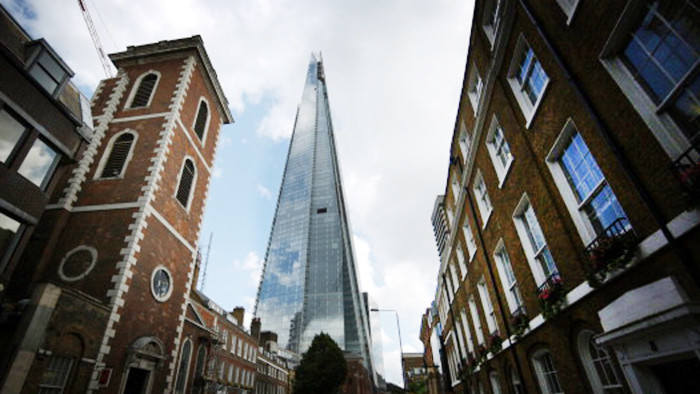The creative tension in London architecture

Roula Khalaf, Editor of the FT, selects her favourite stories in this weekly newsletter.
The appearance of the Shard on London’s skyline has reinforced an old cliché about the city – that its one constant is change. The 70-storey skyscraper dwarfs its neighbour, the Brutalist concrete tower of Guy’s Hospital. When built in 1974, it was the tallest hospital building in the world.
Side by side, they illustrate the change that has occurred in a generation with crisp clarity: the massive shift from public to private, from the functional concrete of a dominant public sector to the slick glass commercial architecture of superstar architect Renzo Piano. Of course, nothing is that simple, Thomas Guy, who founded the hospital in 1721, made his pile in the South Sea Bubble.
Yet the contrast is clear. The Shard hits the medieval street plan of Southwark clumsily, smashing through London Bridge station and casting its shadow over a 12th-century church, Georgian terraces, and the Victorian ironwork of Borough Market. Every change threatens to transform London, usually for the worse, yet it absorbs each wave, every era reinforcing its quirky blend of old and new.
That ability to absorb and adapt has made London an enduring success. The city does not have the most sophisticated architecture. Small cities such as Basel and Porto have bred far more thoughtful architectural cultures. Yet London exports architecture on the grand scale. Practices including Foster & Partners, Rogers Stirk Harbour, Grimshaw, Wilkinson Eyre, David Chipperfield, Terry Farrell and others are among Britain’s greatest and most successful cultural exports.
And for years, they were just that, architects building more abroad than at home. This is another paradox of London: its openness has often excluded its finest designers, shut out by big international and corporate practices and forced to become nimble enough to work anywhere. But they have brought home these skills to create a thriving architectural scene probably unmatched anywhere in its commercial and critical success.
London, unlike many continental cities, has no master plan. There are no big ideas; it relies on the market and on piecemeal developments constantly remaking every quarter. The riverside, developed since the early 1980s, shows the execrable results of lacking a master plan in its mongrel mix of ad hoc speculative towers and low-rise tat. Yet elsewhere real intelligence emerges, as in Argent’s exemplary redevelopment of King’s Cross. Cities in Germany have 10 times as many planners, yet, while they remain provincial, London somehow powers ahead.
The capital’s recent reinvention as an asset class for foreign investment promises to change it again. Combined with the government’s determination to reduce the welfare bill, consequently squeezing out the last working-class Londoners from the centre, this transformation promises to be among the most radical in years.
Yet it also means attention may shift to the less desirable parts surrounding the centre and this leads us to another of the city’s paradoxical strengths: the mediocrity of its fabric.
With swaths of poor, postwar housing, dim commercial development and undemanding Victorian terraces, the city has neither the archaeological density of Mediterranean city centres nor the planned and regulated beauty of Paris or Rome. It also lacks the scale and intent of Manhattan’s grid or Hong Kong’s skyline and its interest lies in demanding that architects think about juxtaposition and about the move from one scale to another, from tight medieval streets to glass and steel skyscrapers.
This constant need to negotiate necessitates (at best) an intelligence in its architecture, an ability to adapt and intervene carefully and thoughtfully – very different from the extrusions frequent in North American cities. It also forces reuse: from Tate Modern in the old Bankside Power Station to Central St Martins art school in a converted granary at King’s Cross, the most impressive new spaces are often not in new buildings but in the carcases of industrial infrastructure.
Ironically, it is this ad hoc environment and blend of the good, the bad and the ugly that allows constant reinvention. It never seems in danger of getting too beautiful and, perhaps, that is a good thing.
Comments